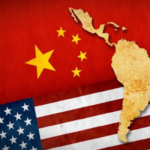
Mercedes Benz with Nazism and the Condor Plan
Mercedes Benz was one of the companies responsible for the genocide in Argentina. Before and during the military-civic dictatorship, the Argentine Army was its main client. As of today, 14 delegates from the Internal Commission of the automotive plant located in Virrey del Pino, La Matanza district, are still missing. In addition, Mercedes Benz Argentina was a supplier to the Latin American dictatorships that formed the Condor Plan.
Mercedes Benz’s relationship with genocidals is long-standing. In its Argentine subsidiary, it had several Nazis occupying hierarchical positions. Among them, Adolf Eichmann, lieutenant colonel of the SS and responsible for the so-called “Final Solution”, the plan with which the Nazis murdered almost six million Jews, two thirds of the total number of Jews living in all of Europe in 1939.

With identity documents forged by the Vatican, Eichmann arrived at the port of Buenos Aires on July 14, 1950. In October of that year, the Police gave him a new identity document. Led by Jorge Antonio, a businessman and collaborator of Perón, he joined Mercedes Benz, when the factory had not yet started production and was being installed in the country.
https://www.laizquierdadiario.com/Julio-D-Alessandro-En-los-70-luchamos-contra-los-nazis-de-la-Mercedes-y-sus-socios-de-Smata
Mercedes Benz was one of the many companies that allied with Nazism and benefited financially, especially from slave labor in concentration camps.
Héctor Ratto, one of the kidnapped workers, assured in his testimony that in 1977 he heard one of the main executives of Mercedes Benz, Juan Ronaldo Tasselkraut, talking on the phone in his office with the military and giving them the address of Diego Nuñez, who was kidnapped. that same day and that he is still missing. This businessman was recently prosecuted at the end of last year for participating in crimes against humanity. The federal judge of San Martín, Alicia Vence, took 7 years to call him for investigation. If this is not guaranteeing impunity!

Worker testimonials
Julio D’Alessandro worked at Mercedes Benz between January 1971 and September 1975, and in the 1970s he was a member of the PRT-ERP. During the coup he had to go into exile in Italy and returned to the country years later. Ramón Segovia worked at the automaker from November 1974 to December 1993. He was an activist at the factory and a member of the PST (Socialist Workers Party) in the 1970s. Both testified as witnesses in the Campo de Mayo Mega-Cause. La Izquierda Diario was present covering these hearings, accompanying the fight for trial and punishment, and at that moment we had the opportunity to interview these comrades.
Julio D’Alessandro told us that: “The persecution in Mercedes Benz began years before the coup, the employers in complicity with SMATA had fired in 1969 the anti-bureaucratic internal commission elected by the workers.”
D’Alessandro described the working conditions imposed by the company and the discomfort that this generated among his colleagues:
“There was a lot of discomfort, especially among the young workers of the company, against the employers and SMATA, they wanted the reinstatement of the dismissed internal commission and working conditions. We had several claims, such as the dining room that was outsourced and there were many cases of poisoning, but the most important claim was for the environment and especially in the summer period. I remember in the summer of 1972 that it was over 30 degrees and although the factory was designed to install air conditioners, the employers never installed them. The establishment was all closed, with gases, acids and they worked with lead”.
Workers’ organization against the company, SMATA and Triple A
In his statement, Julio explained how they were organized: “We were forced to create a clandestine organization, because the bosses and SMATA were pressing us. The company wanted to increase the pace of work, we made a clandestine flyer whose content was decided by activism. In 1974 we took over the factory at the beginning of January and we As hostages apart from the managers, we took their air conditioners. The gangs of the union came to attack us, we knew they were armed and one of them in particular boasted of being a Triple A organization command.”
“The company did not want to stop production for any reason because at that time they were selling many military vehicles to Uruguay, Bolivia, Brazil, Chile and other countries at unbelievably low prices. Mercedes Benz collaborated directly with the Condor Plan”.
Julio describes the repression within Mercedes:“In the factory there were policemen who were spies for the bosses. In 1974 there was already repression and the bosses made lists of fellow fighters, like in Mercedes, like in Acindar, like in Córdoba. The bosses, the spies and the union squeezed us , control was much stricter inside after the takeover of 1974. But the militancy succeeded in having internal commission elections called and we were able to elect a representative commission of the workers, because we did not leave the union, which was the one that controlled the votes , take their weapons. The control and repression were very strong by the Triple A at the national level and the government of Isabel Perón and López Rega had already begun to eliminate opponents of the union bureaucracy. We organized ourselves as coordinators against the union in other factories too, like Chrysler, Citroën, Peugeot”.
Added: “On October 1, 1975, tired of not being able to choose our representatives, we made the famous 22-day strike. Such was the repression and pressure that they spied on us even in our homes. One day I see a car with a guy inside, and when I see a documentary years later I recognize him. It was Lavallen, a commissioner who was head of factory security and who turned out to be the appropriator of the first restored granddaughter in the country, Paula Logares, kidnapped in Uruguay along with her parents, in 1978”. Lavallen himself was the one who kidnapped one of Mercedes’ companions, Alberto Gigena. His wife recognized him and denounced him.
In her statement at the San Justo Brigade Trial, Paula Logares recalled that Lavallén was security personnel for Mercedes Benz. Such is the involvement of the automaker that in 1975 he “donated” a neonatology team to Campo de Mayo, one of the largest clandestine centers of the dictatorship where the largest clandestine maternity hospital in the country operated.
Victoria Basualdo, a historian at the University of Columbia and Flacso and a researcher at Conicet, testified in the same trial in 2019: “This case also illuminates other branches, such as the role played by some union leaders in this repressive process, as clearly shown by the case of José Rodríguez and his role in the persecution from SMATA of the combative sectors.”
It is worth clarifying that in that same trial Julio D’Alessandro and Ramón Segovia also testified. In this interview with La Izquierda Diario Basualdo explains corporate responsibility in the genocide, his relationship with the Nazis, the participation of the union bureaucracy and the involvement of Mercedes Benz in the appropriation of children.
Ramon Segovia: “Mercedes-Benz executives gave the data to the repressors”
Ramón Segovia worked at Mercedes Benz from November 1974 to December 1993. He was an activist in the factory and a member of the Socialist Workers Party in the 1970s. At the time of the interview, he stated: “The responsibility of the company and the economic contributions that Mercedes-Benz made to the dictatorship with money and Unimogs have been proven. They even donated a neonatology team to the Campo de Mayo Military Hospital for captive births in 1975. Mercedes Benz executives gave the data to the repressors”.
“The impunity that Justice maintains, especially for businessmen, is clear. The processes are very long. This is the fifth time that I testify in this case. Beyond the conviction of the two former Ford managers, which is very important, many businessmen and repressors have already died with impunity.”
One of the examples of this is the case of the genocidal businessman Pedro Blaquier.
In his statement in the Campo de Mayo Megatrial, he explained the role of SMATA in the factory and the current general secretary of the union, Ricardo Pignanelli: “He was my sub-delegate after 1977. He was a militant, without our knowing it, of José Rodríguez’s Green and later he openly militated on that list. He was from the bureaucracy, he was a kind of insider. He never did anything for our missing colleagues from Mercedes ”.
As in Mercedes, Ford, Córdoba and so many factories, SMATA was a direct participant in Triple A and collaborated with the dictatorship by putting together lists of fellow opponents.
Segovia assures: “The workers have enormous strength to continue fighting and reverse the situation imposed by the employers with the collaboration of the bureaucracy.”
This March 24, 47 years after the coup, we mobilize for the trial and punishment of all the genocidal and against the impunity that all governments have guaranteed, especially to responsible businessmen. Beyond the speeches, they continued to benefit from an economic system that plunges millions into misery. Together with the Memory, Truth and Justice Meeting from 12 noon we will gather in Plaza Congreso.
Source: www.laizquierdadiario.com

